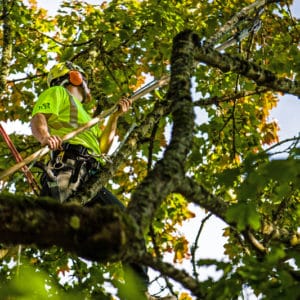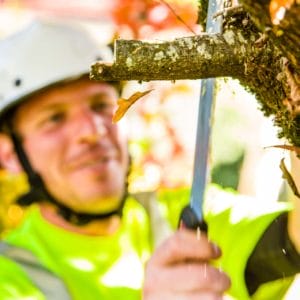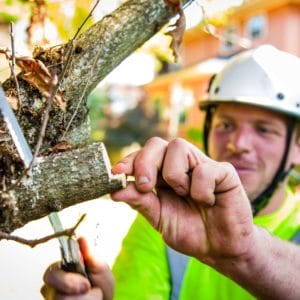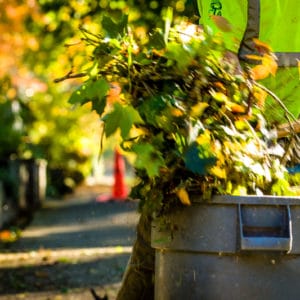
The way you prune trees in Portland depends primarily on the special circumstances of the tree in question. While there are some general rules regarding the different types, timing, and frequency of pruning, in an urban environment that is so rich with trees, the work performed needs to be adjusted to the situation and goals of each tree owner, within reason.
The following are general guidelines for the most common frequencies, timing and types of pruning for the majority of the trees you will find in the greater Portland metro area. If you ever have questions about your particular tree, feel free to call us at 503-226-7143 to schedule an appointment.
Frequently Asked Questions About Tree Pruning
How do I know if my trees need to be pruned? Most if not all mature trees in our urban environment need regular pruning to maintain their health. Trees should be pruned every 2-7 years depending on many factors. Our arborist can estimate the last time a tree was pruned and recommend a pruning schedule.
How often do my trees need to be pruned? Most commonly trees should be pruned every 3-4 years but this could be as much as every year if there are special circumstances or as much as 7 years depending on the type of tree.
My trees have been topped or mis-maintenanced can you fix them? No, we can not undo what has already been done. Your tree will never be as beautiful as it would have been, but we can, over a period of years, reverse some of the damage and return your tree to health and viability.
I hate my neighbor's tree what can I do? Not much. Your best bet is to work with your neighbor to come to a compromise. You could offer to pay half of the costs or get the opinion of an arborist in regard what should be done with the tree. What you should not do is go ahead and prune or remove the tree even if it is on your property. Legal or not (we are not lawyers) this could lead to an expensive legal battle. We can often help Portland neighbors come to a tree cutting compromise, but as a policy we do not do work where neighbors are in disagreement.
My neighbor's tree is threatening my property what can I do? If your neighbor's tree is truly a threat we still recommend you try and work it out with them. There are in this case, a few things you can do to force their hand. One is bring the tree to the attention of the city by submitting an arborist report on the tree. In certain cases they can order it removed. You can also report the tree to their home owners' insurance company or HOA and that may force them to have it taken care of. But we cannot stress enough, how much better things work out in the end, when you can come to an agreement with your neighbor.
Frequency of Pruning
Deciduous trees
Most deciduous trees in an urban environment such as Portland will benefit from pruning every 3-5 years. This frequency may need to be increased if the trees are close to or over structures.
Pruning a tree more heavily less frequently in order to avoid regular pruning often creates the opposite of the desired effect. The tree sends out significant new growth in response to the heavy pruning, resulting in more frequent follow-ups. There is a delicate balance of taking just the right amount that must be maintained, something the arborists at Urban Forest Pro are well-versed in.
If you are wondering what is the best month to trim a maple tree, it is typically late winter to early spring before new growth starts, ensuring the tree heals quickly and promotes healthy growth.
Evergreen trees
Most of the large fir and pine trees in the Portland area need to be pruned every 5-7 years. It is important, however, to inspect trees for changes that may affect their health and therefore their pruning schedule during this time. When in doubt, ask an arborist.
Cedars and other evergreens should be pruned every 3-5 years in most cases. This frequency may need to be increased if the trees are close to or over structures, which many trees in the area are. Again, when in doubt, it is always better to get the opinion of a professional than damage one of our area’s greatest resources.
Ornamental trees
Most ornamental trees can be pruned at the specific tastes of the owner. Most commonly, these types of trees are pruned yearly or every other year. Some however, are pruned as much as twice a year to achieve the desired look. It depends on the preferences of the owner and the situation more than anything.
Timing of Pruning
The timing of pruning your trees is very dependent of the type and condition of the tree. If your tree has not been regularly maintained, the best time to prune is now. If you have kept to a regular tree pruning schedule then the best timing for pruning will depend on the type of tree and your convenience. Learn more in this discussion about the best time to trim a maple tree.
Types of Pruning
Full Pruning
Bring out the best in your trees and shrubs by showcasing what nature already did. The form of the tree is strengthened, accented, and cleared by removing what does not fit.
Dead, diseased, rubbing, and duplicated limbs are eliminated. Additionally, we remove at most 10-20 percent of the tree crown. The greatest compliment we receive is when the owner says, "It doesn't look pruned, it just looks better!"
Better aesthetics will lead to better health for your tree. Opening things up and removing the excess and dead limbs allow more air to circulate through the remaining limbs and branches. This increased air circulation can improve a wide range of tree health issues, from insect colonies to fungal growth, all without the need for chemical intervention.
 Heavy Thinning
Heavy Thinning
On occasion, a tree can grow too large for its setting or too old to support some of the furthest growth from the root system. In these cases, we will sometimes suggest tree removal and replanting. However, there is a pruning remedy. Crown reduction pruning is a way of cutting back tips and leaving certain leaders to create a new, lower crown.
This time-honored professional practice should not be confused with topping, which we do not perform. Topping is the indiscriminate lowering or shaping of a tree to arbitrary points between nodes or branches. Because topping makes a tree more susceptible to disease and other problems, it is never recommended by Urban Forest Pro, unless there is a specific need.
Crown Restoration
If a tree has been topped, we can begin the process of restoration with the first pruning. We reduce the amount of leaders struggling for light, and separate these as evenly as possible. If done properly, after a pruning cycle lasting several years, a tree that has been "ruined" can often be reclaimed, and go on for years and years after the event.
Crown Lifting
Ever notice how deadwood seems to gather at the bottom of pine and fir trees? Growth is mainly a function of available light. Light, for a tree, is food, and leaves are the tree's stomach. When a tall, straight tree gains more growth on top, it is natural that it will lose limbs on the bottom.
We anticipate this action by pruning the lowest limbs on many of our native conifers and some of our large native deciduous trees, like big leaf maples. It keeps them healthy and encourages upward growth.
Formal Pruning
When a tree is planted for fruit, flowers, or to conform to a space that is too small for the norm in nature, it can be pruned formally to keep a desired shape. If the pruning is done regularly and properly, it can be a thing of beauty and usefulness. Unfortunately, we find many trees that have started out formally but been let go. If it's feasible, we save the tree. That is always our first goal. However, if it is not possible, we will recommend removal and replanting.
Call Us for Your Free Estimate
Our whole purpose is to work with homeowners and businesses to preserve the natural beauty of our tress here in the greater Portland, OR. Tree pruning is a vital part of that process and in many cases can be utilized to save a tree that seems too far gone. If you have any questions about pruning your trees, or tree root pruning, or do I need a permit to cut down trees on my property, feel free to call us at 503-226-7143 and arrange a meeting with one of our certified Portland arborists. We would be happy to examine your unique situation and explore all your options with you.
The different tree trimming types, the timing of tree trimming, and frequency depend on the special circumstance of the tree. For your information, we have provided a description of the most common frequencies, timing & types of pruning below.
Contact us for tree cutting services in Clackamas, OR.
Ideal Tree Trimming Frequency
 DECIDUOUS TREES
DECIDUOUS TREES
Most deciduous trees in an urban environment will benefit from trimming every 3-5 years. This frequency may need to be increased if the trees are close to or over structures. Trimming a tree more heavily to avoid regular pruning often creates an opposite effect, when the tree sends out significant new growth in response to the heavy trimming. There is a delicate balance of taking just the right amount that must be maintained.
EVERGREEN TREES
Most of our large fir and pine trees need to be trimmed every 5-7 years. It is important, however, to inspect trees for changes that may affect their health and therefore their trimming schedule during this time. When in doubt, ask an arborist. Cedars and other evergreens in most cases should be trimmed every 3-5 years. This frequency may need to be increased if the trees are close to or over structures.
ORNAMENTAL TREES
Most ornamental trees, like Japanese Maples, can be trimmed at the specific tastes of the owner. Most commonly, these types of trees are trimmed yearly or every other year, but some are trimmed as much as twice a year to achieve the desired look.
The Timing of Tree Trimming
Timing of tree trimming is very dependent on the type and condition of the tree. If your tree has not been regularly trimmed, the best time to trim is now. If you have regularly maintained your tree through trimming, the best timing depends on the type of tree.
FULL TRIMMING
Bring out the best in your trees and shrubs by showcasing what nature already did. The form is strengthened, accented, and cleared by removing what does not fit. Dead, diseased, rubbing, and duplicated limbs are eliminated, and 10% to 20% of the live crown is all we remove. The greatest compliment we receive is when the owner says, "It doesn't look pruned, it just looks better!" Better aesthetics mean better health. Air circulation can improve problems ranging from insect colonies to fungal growth - without chemical intervention.
 HEAVY THINNING
HEAVY THINNING
Sometimes, a tree has grown too large for its setting or too old to support some of the furthest growth from the root system. In these cases, we sometimes suggest removal and replanting, but there is a pruning remedy. Crown reduction pruning is a way of cutting back tips and leaving certain leaders to create a new, lower crown. This time-honored professional practice should not be confused with topping, which we do not perform. Topping is the indiscriminate lowering or shaping of a tree to arbitrary points between nodes or branches. Because topping makes a tree more susceptible to disease and other problems, it is never recommended by Urban Forest unless there is a specific need.
CROWN RESTORATION
If a tree has been topped, we can begin the process of restoration with the first pruning. We reduce the number of leaders struggling for light and separate these evenly as possible. If done properly in a cycle of years, a tree that has been "ruined" can often be reclaimed, and go on for years and years after the event.
CROWN LIFTING
Ever notice how deadwood seems to gather at the bottom of pine and fir trees? Growth is mainly a function of available light. Light, for a tree, is food, and leaves are the tree's stomach. When a tall, straight tree gains more growth on top, it is natural that it will lose limbs on the bottom. We anticipate this action by pruning the lowest limbs on many of our native conifers and some of the large native trees, like big leaf maple. It keeps them healthy and encourages upward growth.
FORMAL PRUNING
When a tree is planted for fruit, flowers, or to conform to a space that is too small for the norm in nature, it can be pruned formally to keep the desired shape. If the pruning is done regularly and properly, it can be a thing of beauty and usefulness. Unfortunately, we find many trees that have started out formally but been let go. If it's feasible, we save the tree, and if not, we recommend removal and replanting.
Trimming Specific Types of Trees
You might be wondering:
- How to prune a Japanese maple
- How to prune Pine/Evergreen Trees
- What is the Best Month to Trim a Maple Tree?
- How to prune Fruit Trees
- Can You Prune Trees in Summer?
- 5 Signs a Tree is Dying
If you're looking for expert tree trimming services in Vancouver, WA contact Urban Forest Pro today.
What Our Clients Have to Say
"We liked how Urban Forest Pro pruned a deodora cedar at our neighbor's house, so we gave them a try. And, our entire project from start (estimate) to finish was completed in a week. The estimator, Jeff, was very friendly and honest. The estimate was very reasonable. And, the 3-member crew was very professional in both pruning and cleanup."
Rating: 5/5 ⭐⭐⭐⭐⭐
Jeannie V
May 2018
Read more reviews on Houzz!
 Heavy Thinning
Heavy Thinning